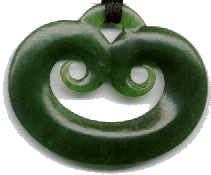General
> Pronunciation
Guide and Notes
> Introduction
to Grammar
> Description
of Designs Used
> Reo
Māori Sound Files
> Reo Māori Flash Cards
Any corrections or comments are welcome. Contact me.
Last updated 28
December 2000.
Site
History
Basic Notes on Te Reo
Throughout this web page I refer to "the" Māori language. This is because I have been taught a modern, standardized version. In fact, each tribe (iwi) has their own variations, so I might be better off to refer to the many Māori languages. The language I have been taught should be recognised and understood throughout Aotearoa/New Zealand, but the differences should not be overlooked.
Because the written Māori language has been developed phonetically from the oral, the written language is much more consistent and easier to spell than English.
Like English, there are five vowels: a, e, i, o, u. These are pronounced to rhyme with "are there three or two": "arr eeh ee or oou". I generally have the most trouble with "e". It can help to mentally place an "h" after the "e" or to say "egg" but stop before the "g"s. The "o" is NOT pronounced as the English "oh", but always as "or", so you can mentally place an "r" after each one. The final trap is to remember the "i" is pronounced the same way English people say the letter "e".
There are fewer consonants than in English (h, k, m, n, p, r, t, w, ng, wh) and their pronunciation is generally similar enough to English that you do not need to worry. Most New Zealanders know "wh" is pronounced as an "f" and "ng" as exactly the same as the English ending "-ing". The letter "r" is worthy of special mention since it is a softer sound than in English, perhaps half way between an "r" and an "l" or "d". It is called the "one tap" r, since the tongue taps the roof of the mouth once (just like the English "d" and "l"). You could try substituting "l"s (or "d"s) for "r"s and see how it sounds, but the Māori "r" is its own sound.
There are tribal variations to the pronunciation of some of the consonants (never, to my knowledge, with the vowels). The "wh" sound, usually an "f", can be pronounced like an "h", "w", or as English "wh". This is the reason you will hear of both Wanganui and Whanganui, for example. The Ngai Tahu pronounce the "ng" sound as a "k". Hence, they are often called Kai Tahu. The "k" is sometimes underlined to show that it is "really" an "ng". This is why you will hear of both Aoraki and Aorangi when people refer to the place officially known as Aoraki Mt Cook.
In Māori, the emphasis on syllables is different to English. In general emphasise the first syllable, unless you know (or have been told) to do otherwise. Note that all syllables end in vowels.
Long vowel sounds are indicated by a macron (or potae or tohu tō) over the letter (hence "Māori" rather than "Maori"). On computers this is supported using the Unicode or UTF-8 character sets.
Because Unicode is a relatively modern standard, not all computers, browsers or fonts support it. If this is the case for you, these pages will not be displaying properly. You will probably be seeing "M?ori" instead. Netscape users may be able to select view/character set/unicode to correct this, otherwise the solution may be a software upgrade. There is more information here.
Another way of representing long vowel sounds is to double the vowel letter (hence "Maaori", rather then "Māori"). This is considered acceptable by the Māori Language Commission (or so I understand) and it is the technique that has been used on this web site until the end of 2000. Some pages may still use this convention, as I have not yet finished the conversion. Doubled vowels look a bit strange to people who are not used to it, and creates a certain amount of ambiguity in the case of genuine double vowels (such as the word "ātaahua" - "beautiful").
A third approach has been used in many situations which is to use a special font (called a Māori font or Pacific language font) that redefines the characters with the German umlaut (such as "ä") to have macrons. This requires the document reader to also install this special font and to understand its use and meaning. With Unicode such measures are no longer necessary.
![]()
Introduction to Te Reo Grammar | Reo Maaori Sound File Collection
Copyright © 1999, 2000 Gavin Kingsley. Contact me.
